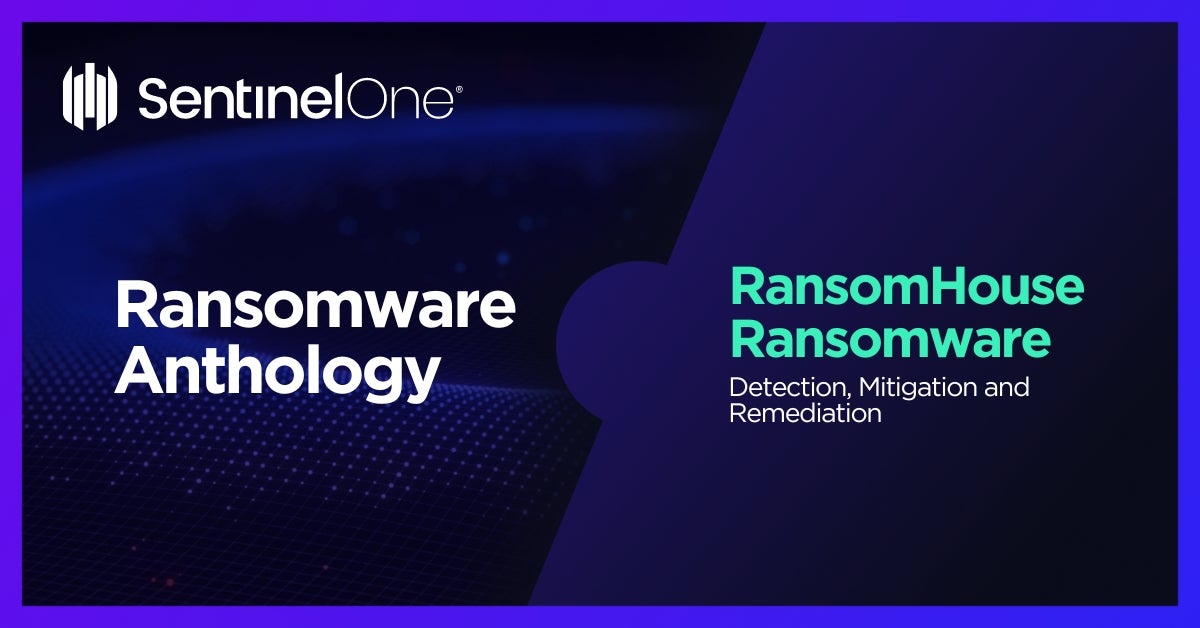RansomHouse Ransomware: In-Depth Analysis, Detection, and Mitigation
What is RansomHouse Ransomware?
RansomHouse emerged in March of 2022 and is categorized as a multi-pronged extortion threat. The attackers exfiltrate all enticing data and threaten to post it all publicly. In the words of RansomHouse representatives, the group claims to not encrypt data and that they are “extortion only”. Further, RansomHouse has positioned itself as a ‘force for good’ in that their breaches are meant to ‘shine a light’ on lacking companies. As of 2023, the group is observed to accept payment in Bitcoin only.

What Does RansomHouse Ransomware Target?
RansomHouse ransomware is known to target large enterprises and high-value targets.
How Does RansomHouse Ransomware Work?
RansomHouse ransomware targets its victims through phishing and spear phishing emails. They are also known to use third-party frameworks (e.g., Vatet Loader, Metasploit, Cobalt Strike).
RansomHouse Ransomware Technical Details
RansomHouse operations tend to be ‘smaller’ or more ‘controlled’ than some of the bigger players. They openly solicit new ‘team members’ on known underground marketplaces, as well as collaborating on the Telegram service.
The group has opted for the more efficient route of exfiltration only. This means that the group simply steals victim data; skipping the encryption step. This can make the attacks stealthier and can potentially lead to a much longer dwell time since no encryption means fewer alarms are triggered. Victims, as well as journalists and reporters, are directed to RansomHouse’s ‘PR Telegram Channel’ for any questions or support around the group’s campaigns.
How to Detect RansomHouse Ransomware
The SentinelOne Singularity XDR Platform detects and prevents malicious behaviors and artifacts associated with RansomHouse ransomware.
If you do not have SentinelOne deployed, here are a few ways you can identify RansomHouse ransomware in your network:
Security Tools
Use anti-malware software or other security tools capable of detecting and blocking known ransomware variants. These tools may use signatures, heuristics, or machine learning algorithms, to identify and block suspicious files or activities.
Network Traffic
Monitor network traffic and look for indicators of compromise, such as unusual network traffic patterns or communication with known command-and-control servers.
Security Audits
Conduct regular security audits and assessments to identify network and system vulnerabilities and ensure that all security controls are in place and functioning properly.
Education & Training
Educate and train employees on cybersecurity best practices, including identifying and reporting suspicious emails or other threats.
Backup & Recovery Plan
Implement a robust backup and recovery plan to ensure that the organization has a copy of its data and can restore it in case of an attack.
How to Mitigate RansomHouse Ransomware
SentinelOne Singularity XDR Platform prevents RansomHouse ransomware infections. In case of an infection, the SentinelOne Singularity XDR Platform detects and prevents malicious behaviors and artifacts associated with RansomHouse ransomware.
SentinelOne customers are protected from RansomHouse ransomware without any need to update or take action. In cases where the policy was set to Detect Only and a device became infected, remove the infection by using SentinelOne’s unique rollback capability. As the accompanying video shows, the rollback will revert any malicious impact on the device and restore encrypted files to their original state.
In case you do not have SentinelOne deployed, there are several steps that organizations can take to mitigate the risk of RansomHouse ransomware attacks:
Educate employees
Employees should be educated on the risks of ransomware, and how to identify and avoid phishing emails, malicious attachments, and other threats. They should be encouraged to report suspicious emails or attachments, and to avoid opening them, or clicking on links or buttons in them.
Implement strong passwords
Organizations should implement strong, unique passwords for all user accounts, and should regularly update and rotate these passwords. Passwords should be at least 8 characters long and should include a combination of uppercase and lowercase letters, numbers, and special characters.
Enable multi-factor authentication
Organizations should enable multi-factor authentication (MFA) for all user accounts, to provide an additional layer of security. This can be done through the use of mobile apps, such as Google Authenticator or Microsoft Authenticator, or the use of physical tokens or smart cards.
Update and patch systems
Organizations should regularly update and patch their systems, to fix any known vulnerabilities, and to prevent attackers from exploiting them. This includes updating the operating system, applications, and firmware on all devices, as well as disabling any unnecessary or unused services or protocols.
Implement backup and disaster recovery
Organizations should implement regular backup and disaster recovery (BDR) processes, to ensure that they can recover from ransomware attacks or other disasters. This includes creating regular backups of all data and systems and storing these backups in a secure, offsite location. The backups should be tested regularly to ensure that they are working and that they can be restored quickly and easily.